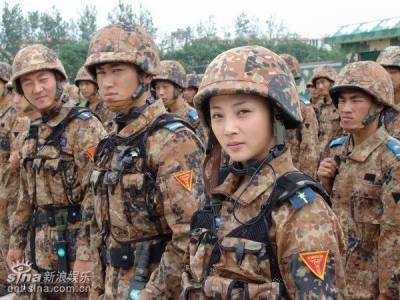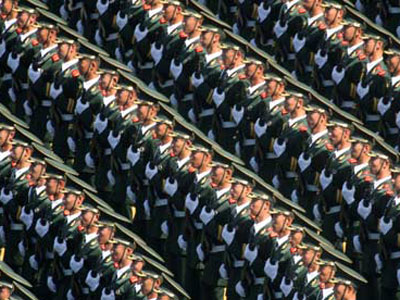
RED CHINA
The
Economist
The People's Republic of China is on course to become the world’s largest military spender in just 20 years. It is investing in thousands of accurate land-based ballistic and cruise missiles, modern jets with anti-ship missiles, a fleet of submarines, long-range radars and surveillance satellites, and cyber and space weapons. China aims to threaten American bases in the western Pacific and to control the Yellow Sea, South China Sea, and East China Sea by pushing U.S. carrier groups beyond the first island chain. But China already has its empire. The PRC consistently devotes just over 2% of GDP to defense, whereas America spends 4.7%.
 The PLA war camo looks good this season |
 The PLA masses are impressive too |
 This PLA honor guard looks quite smart |
 This PLA militia looks almost sexy |
 The PLA Type 99G is a modern tank |
 The PLA has a force of LCAC assets |
Chinese Military Power
Edited by Andy Ross
China has been increasing its defense budget steadily for two decades.
Annual defense spending rose from over $30 billion in 2000 to almost $120
billion in 2010. Total military spending in 2012 may be around $160 billion.
On present trends, China's defense spending could overtake America's after
2035.
The People's Liberation Army is still the largest army in the
world. Run by the Communist Party of China and its Central Military
Commission, the PLA an active force of 2.3 million. But the 1991 Gulf War
convinced the PLA that its huge ground forces were militarily obsolete.
China is developing anti-access/area denial (A2/AD) capabilities that
use pinpoint ground attack and anti-ship missiles, a growing fleet of modern
submarines, and cyber and anti-satellite weapons to destroy or disable
hostile military assets from afar. In the western Pacific, A2/AD means
targeting or jeopardizing U.S. Navy carrier groups and U.S. Air Force bases
in Okinawa, South Korea, and Guam. America's allies in the region could no
longer rely on U.S. support to deter aggression or to resist coercion.
China plans to be the regional hegemon. At the Academy of Military
Science in Beijing, PLA scholars are learning all they can from American
think tanks about the revolution in military affairs (RMA) triggered by
exponentially greater computing power. General Chen Zhou: "We studied RMA
exhaustively."
China has made big investments in the air force, the
navy, and the Second Artillery Force, which operates nuclear and
conventional ballistic missiles. The Chinese call the deployment of advanced
military platforms "mechanization". In the next decade, China will network
the new weapons for the battlefield through "informatization" (C4ISR:
command, control, communications, computers, intelligence, surveillance, and
reconnaissance). The two processes should be completed by 2020.
On
current trends, China will soon be able to deploy satellites and
reconnaissance drones, thousands of surface-to-surface and anti-ship
missiles, more than 60 stealthy conventional submarines and at least six
nuclear attack submarines, stealthy manned and unmanned combat aircraft, and
space and cyber warfare capabilities. In addition, the navy is considering
aircraft carriers, which would unmistakably declare an ambition to project
power far from home and counter expected moves by Japan and India. The new
Chinese assets are mostly asymmetric, designed not to match American
military power in the western Pacific but to exploit its vulnerabilities.
Taiwan is the main spur for China's military modernization. In 1996,
America reacted to Chinese ballistic missile tests carried out near
Taiwanese ports by sending two carrier groups into the Taiwan Strait. Since
2002, China's strategy has focused on a cross-Strait armed conflict in which
China's forces would not only confront opposition from Taiwan but also
neutralize an American attempt to intervene. In 2005, China passed the
Taiwan Anti-Secession Law. China Institute of International Studies thinker
Jia Xiudong: "The first priority is Taiwan. The mainland is patient, but
independence is not the future for Taiwan. China’s military forces should be
ready to repel any force of intervention."
In 2004, Chinese premier
Hu Jintao said the PLA should be able to undertake "new historic missions".
China has become the biggest contributor of UN peacekeeping troops among the
permanent five members of the Security Council. Responsibility for most of
these new missions has fallen on the navy, which also guards Chinese
economic interests by supporting sovereignty claims, protecting Chinese
shipping, preserving access to energy and raw materials supplies, and
safeguarding Chinese citizens who work abroad. The navy’s growing fleet
enables it to carry out extended "green water" operations and will in future
allow longer-range "blue water" missions.
China's neighbors and the
West in general should worry about these developments. The longer-term
trends are in China's favor. But the threat should not be exaggerated:
1 China has a vital national interest in the stability of the global economic system. Its military leaders constantly stress that development takes precedence over military ambition. For many years China has spent just over 2% of GDP on defense, less than half the U.S. rate. China's leaders worry more about internal threats to their control than external ones. Last year, spending on internal security outstripped military spending for the first time.
2 China has a sense of its place in the world and wants its armed forces to reflect that. General Yao Yunzhu of the Academy of Military Science: "We are criticized if we do more and criticized if we do less. The West should decide what it wants."
3 China’s military technology has suffered from the Western arms embargo imposed after the Tiananmen Square protests of 1989. China’s defense industry may be improving but it remains inefficient and dependent on imports from Russia. The PLA also has little recent combat experience. It lost its last war against Vietnam in 1979. In contrast, a decade of conflict has honed American forces to a new pitch of professionalism.
General Yao says China has no need to be a military peer of the United States: "But perhaps by the time we do become a peer competitor the leadership of both countries will have the wisdom to deal with the problem."
The People's Republic of China celebrates its 60th birthday with missiles
